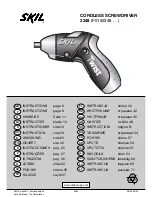
16
OPERATION INSTRUCTIONS
SWITCHING ON AND OFF
Hold the tool firmly to control the twisting of
the tool.
To prolong the life of the tool never overload
it. Start the tool by squeezing the variable
speed trigger switch. Release the trigger to
stop the tool.
This tool has a variable speed switch that de-
livers higher speed and torque with increased
trigger pressure. Speed is controlled by the
amount of switch trigger depression.
The variable speed feature is particularly use-
ful when driving screws. It also enables you to
select the best speed for a particular application.
NOTE: It is recommended to use the variable
speed feature for a short time only. Do not
continuously operate the tool at different
speeds. It may damage the switch.
SCREW DRIVING
NOTE: Try to use the modern design of screws
for easy driving and improved grip.
· Install the correct driver bit.
• Ensure that the torque adjustment collar is
set to the most suitable setting. Push the dual
range gear selector to the position “Lo” to
choose low speed. If in doubt start with a low
setting and gradually increase the setting until
the most suitable position is found.
• Use the correct speed for the job, apply mini-
mal pressure to the trigger initially.
Only increase the speed when full control can
be maintained.
• It is advisable to drill a pilot hole first, slightly
longer and just smaller than the shank diame-
ter of the screw to be fitted. The pilot hole will
act as a guide for the screw and will also make
tightening of the screw less difficult.
• When screws are positioned close to an edge
of the material, a pilot hole will also help to
prevent splitting of the wood.
• Use the correct countersinking bit to ac-
commodate the screw head so that it is not
“proud” of the surface.
NOTE: If the screw becomes difficult to drive
home, remove and try a slightly larger or lon-
ger hole but remember there must be enough
material for the screw to grip! If restarting a
screw in a hole, locate and make the first few
turns by hand. If the screw is still difficult (as
when using very hard woods) try using a lubri-
cant such as soap; liquid soap is usually best.
Keep sufficient pressures on the drill to pre-
vent the bit turning out of the screw head. The
screw head can easily become damaged mak-
ing it difficult to drive it home or even remove it.
HOLE DRILLING
ATTENTION: When attempting to drill a
large diameter hole, it is sometimes best to
start with a smaller drill bit then work up to
the required size. This prevents overloading
the drill.
• Set the tool to the DRILL mode and push the
dual range gear selector to the position “Lo”
to choose low speed.
NOTE: Remember to use a “wood-pecker” ac-
tion on deep holes to allow the swarf to be
ejected from the hole.
If the drill bit snags, switch off immediately to
prevent permanent damage to the drill. Try to
run the drill in reverse to remove the bit.
• Keep the drill in line with the hole. Ideally,
the drill bit should enter at right angles to the
work. If the angle is changed during drilling,
this could cause the bit to snap off blocking the
hole and perhaps causing injury.
• Reduce pressure as the drill is about to break
through the item being drilled.
• Don’t force the drill, let it work at its own pace.
• Keep the drill bit sharp.
DRILLING WOOD
ATTENTION: For maximum performance
when drilling larger holes, use auger bits or
spade bits for wood drilling.
• Set the tool to the DRILL mode and push the
dual range gear selector to the position “Hi” to
choose high speed.
• Begin drilling at a very low speed to prevent
the bit from slipping off the starting point. In-
crease the speed as the bites into the wood.
• When drilling through holes, place a block
of wood behind the work piece to prevent
ragged or splintered edges on the backside of
the hole.
DRILLING MASONRY
ATTENTION: For maximum performance,
use high quality carbide-tipped masonry drill
bits when drilling holes in brick, tile, concrete
etc.
TB1012 manual.indd 16
08/12/15 12:12 p.m.





































